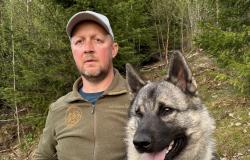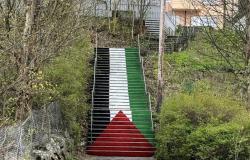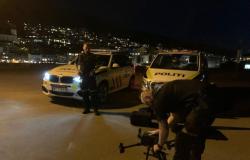Earlier this year, it was written in large letters in VG that one should stay inside when “Ingunn” was going to wreak havoc outside. In a competing student newspaper, it could seem that the news had not reached the students’ ears, and there was a nonchalantly positive tone across the board. Crisis preparedness was not clear for most; didn’t we focus on prepping?
The Directorate for Safety and Preparedness (DSB) describes self-preparedness as prepared material and knowledge that one should have to cover basic needs for at least three days in the event of an incident or crisis situation. This is a recommendation that applies to all social groups at all times, including students.
However, a survey from 2022 made for DSB shows that young city dwellers score the worst when it comes to self-preparedness. The majority of students quickly fall under this category, and just under 20 per cent of Trondheim’s population are precisely students.
Food is not the first priority
– Tank with water, matches, canned food and oatmeal are things you should have, but I live in a collective now and don’t have space to store it.
So says psychology student Elise Rokne Kålen, together with fellow students Solveig Berget and Ada Leivestad Mork. They indicate that they are aware of the recommendation, but believe that lack of space is the obstacle for many students. The students themselves have not thought much about preparedness. Mork laughs and rather clarifies the importance of working technology for today’s young people.
– When the power went out a little while ago, I first thought about whether we had a power bank and didn’t have food as the first priority, although perhaps you should, says Mork.
Berget adds that a habitual optimism about living in a safe country can lead to one not preparing.
– You probably think that it will probably go well regardless, she says.
David Bashir and Teo Marø, who also study psychology at NTNU, don’t have much knowledge of self-preparedness either, but recognize the optimism of the girl gang.
– I think few students prepare, because it is so expensive, but also because it is so rare that you need such things here in Norway, says Marø.
ALSO READ: You won’t believe how you can save these cuties
“Putin Warehouse”
Some students, on the other hand, are more prepared. Bachelor student Marthe Skogvoll is one of these, but sees that she may not be a completely ordinary example of a student.
– I am probably more mature than other students. I have children and therefore made a stock. The children call it the “Putin Warehouse”, she says with a laugh.
Self-preparedness had been brought up as a topic in a conversation she had with other students, and the vast majority did not follow the recommendation. However, she clarifies that space is an important factor.
– Where are you supposed to store nine liters of water per person?
Fellow student Marie Haugerud Bredesen nods affirmatively and points out that her household has not thought about self-preparedness precisely because they do not have that much space and finances. Rather, they prioritize the purchase of everyday necessities.
– I don’t think prepping is the first thing you think about as a student, she says.
Tight – in both the economy and housing
Education students Lisa Marie Schieldrop and Selma Briså Sjølund both come from families that have crisis preparedness, especially created after war broke out in Europe. They still see limitations in organizing such a warehouse in their own student accommodation.

– Neither space nor finances are sufficient to be able to have emergency stock for several days. On the other hand, you always have some dry goods lying around, but prepping is not the main reason why I have them, says Schieldrop.
She also believes that many students recognize their situation. In addition, she mentions that less flow of information on the topic may be a contributing factor.
– Prepping is not so much on the agenda now, so I don’t think that many students do it. At Fagland are Anna Elida Hoff and Sofie Fagerbakk Klepp, who are both studying sign language interpretation.
When asked if they are aware of the recommended self-preparedness, there are a few things they consider essential.
– I personally wouldn’t have had space for any storage, but a power bank is important to have, says Klepp.
Thematically appropriately, Klepp has “Doomsday” written on the hoodie.
– And medication, adds Hoff.
September 11, 2001

Sociologist, researcher and professor in security management at NTNU Stian Antonsen understands the students’ situation well.
– After all, all the experience we have suggests that we will not be able to use our own preparedness. At the same time, young people today are probably more used to the fact that most of what you need is available when you need it.
Antonsen says that it has not been that many years since he seriously started with his own emergency stockpile, although his interest in social security goes back a long way. We meet him on campus at NTNU, where he is currently employed as a professor. He reminisces about his past as a student.
– I first became interested in the subject in connection with the terror attack in the World Trade Center on 11 September 2001. My lecturer at the time crossed everything off the agenda and put security research on the syllabus. It was only then that I discovered that it was a separate field of study.
Antonsen remembers it as a new era for sociology. The students got the impression that the world was now changing, and that as sociologists they had to look at what this meant. He is currently the course manager for the course Risk assessment, social security and critical infrastructure at NTNU.
– If the gaffe doesn’t work, it’s vulnerable in the first place
The professor seems almost a little eager to test out the emergency stockpile. He talks passionately about a recent power outage during a storm that was predicted to last for a while.
– I thought “finally!”, ran down to the basement and brought out a flashlight, Uno, Real tourmat of various kinds and was ready as an egg.

To Antonsen’s disappointment, it took less than an hour before the electricity returned, bringing with it a kumbaya atmosphere. The family didn’t even manage to complete the round with Uno. On the other hand, he clarifies that it is good to know that the infrastructure is working.
– There is no reason to think that Norway is not a safe society – all experience indicates that the systems are good. I think this was the longest blackout I’ve experienced since I was a kid.
He goes on to say that although he is an eternal optimist, he still has the cellar full of canned goods, water and newly acquired iodine tablets. Antonsen clarifies that despite the fact that it is not an imminent danger, it is still relevant enough for one to take it to heart.
– I probably have what the authorities recommend for self-preparedness, in addition to large quantities of duct tape. It is therefore the world’s most flexible tool, a real McGyver scheme. What you can’t fix with duct tape is vulnerable in the first place, he says humorously.
The professor gives the impression that there has been some sport in the preparation, but that he still does not make it more difficult or more expensive than it needs to be. He is keen to use equipment he already has and to use things in several contexts. Universality is a key word when it comes to equipment, but also when it comes to food storage.
– I have a fanatical relationship with tinned tomatoes. You can therefore make so many different dishes, as long as you have something to warm up with.
Demographic factors
However, not everyone has a large basement to store goods in. Demographic factors such as residence, income and community seem to influence, as well as awareness.
– Vulnerability is very unevenly distributed in a population. Self-preparedness requires space and maintenance, and it costs money.
He makes a rough distinction between two types of vulnerability, where one deals with the material need and the other with the social vulnerability in a society. He cites the covid-19 pandemic as an example.
– The pandemic was a stress test of what society can withstand. One also gained some insight into the social vulnerability, which became visible as a result of a lack of networks and all that entails.
Antonsen adds that it is still not “every man for himself” in a possible crisis situation, but refers to the airplane metaphor of putting on your own mask first, before you help others.
– There is a reason why we have a long history of being in groups; you are stronger together. On the other hand, it is about an awareness of self-sufficiency, so that the most vulnerable can get help first.
A balancing act between preparation and fear
Antonsen mentions trends such as geopolitical unrest, pandemics, climate change and extreme weather as risk factors in today’s society.
– So there is a varied menu of misery, and perhaps it is therefore wise to ask yourself the question of preparedness. You must have general resources such as water and heat anyway.
Although Antonsen points out that there are many ways to be vulnerable today, he believes there is an important balancing act between preparation and fear. He offers some tips.
– It might be a good idea to think about what you use on a daily basis. Take things a little more seriously, without having to go around being afraid for that reason.
He adds that components of self-preparedness are typically included in a student relationship anyway. Cracked bread, oatmeal and canned food are highlighted as good examples. On DSB’s site sikkerhverdag.no, you can read more about safety in everyday life, including self-preparedness.
ALSO READ: – 110 years of traditions are at risk
Tags: Student preparedness
-









